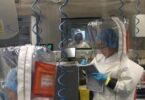 In the newer generation Batman shows, genetic engineering has developed to the point where human DNA can be spliced with animal DNA, creating people (usually teenagers) that look and act like a human-animal hybrids. In real life, genetic engineering cannot go quite that far. These days, scientists are excited when they can program bacteria to produce large amounts of lycopene or to glow at a specific time. Yet, while the power to manipulate and synthesize new genes isn’t producing hyena men, it still excites those who hope these technologies will create new therapies to fight disease. Others worry bio-terrorists could use these technologies to develop newer and more powerful super bugs.
In the newer generation Batman shows, genetic engineering has developed to the point where human DNA can be spliced with animal DNA, creating people (usually teenagers) that look and act like a human-animal hybrids. In real life, genetic engineering cannot go quite that far. These days, scientists are excited when they can program bacteria to produce large amounts of lycopene or to glow at a specific time. Yet, while the power to manipulate and synthesize new genes isn’t producing hyena men, it still excites those who hope these technologies will create new therapies to fight disease. Others worry bio-terrorists could use these technologies to develop newer and more powerful super bugs.
Researchers at Harvard Medical School have recently revolutionized the field of genetic engineering. Traditionally, scientists have had to use a labor-intensive process to break up, reassemble, and reinsert genes. Cutting up genes and gluing in new strands of DNA, one by one, takes time. Besides that, the researchers don’t know what gene combination is going to produce the desired or best results. Scientists have therefore had to painstakingly go through millions or billions of efforts before they find the one that works. Programming bacteria to, say, fight cancer, can therefore take years.
“It’s nearly impossible to predict which combinations of mutations will confer the desired behavior,” explains postdoctoral researcher Farren Isaacs. “Biology is so complex that we don’t know the optimal solution.”
Harris Wang, Isaacs and other researchers at Professor George Church’s lab at Harvard Medical School have found a way to speed things up. Through a process called multiplex automated genome engineering (MAGE), they generated 15 billion different genomic patterns in just three days. As a result, they developed an E coli strain that could produce five times the normal amount of lycopene, an antioxidant that is believed to hold back the onset of cancer.
Harris said, “Can you imagine how long it would take to generate 15 billion genetic variants with traditional cloning techniques? It would take years.”
MAGE takes single strands of DNA that are synthesized to fit on specific sections of the genome. The target cell gets a blast of energy, which opens it up so the DNA can slide in and reproduce itself. The prototype MAGE machines at Harvard automate this process, doing it over and over with different gene combinations.
Through this process, the Harvard researchers were able to develop tiny E coli factories for lycopene in just three days. The success has created hope that other bacterial factories for proteins or drugs or fuel can be developed quickly.
“Automated sequencing really advanced the way we can read genetic information. We hope automated genome engineering will advance the way we write genetic information,” said Wang.
Because the MAGE process allows researchers to quickly produce genetic variants, it may be useful in creating treatments for drug-resistant bacteria. It may anticipate possible mutations and strains of diseases in advance. At the same time, it could be used to develop extremely deadly diseases and infections that potentially be used against the world populations.
Even without the threat of bio-terrorists, genetic engineering presents tremendous ethical questions. The ability to engineer DNA, to create genetically novel bacteria, plants or animals, steps us up onto seriously precarious ground. Biology is indeed extremely complex and the genetic code is not fully understood. It is a fascinating field, certainly. But the prospect of creating new microscopic creatures without knowing the full impact of the effects of gene restructuring¦ we can’t even imagine what accidental destruction might result. With great power¦ comes great responsibility.
Source: http://www.khouse.org







